Ever tried designing a garden on a mountainside? Let me tell you—it’s like solving a Rubik’s cube on roller skates.
Once, I created swales to catch rainwater. Yes, my backyard looked like a trendy water feature, but those *Salvia officinalis* and *Echinacea purpurea* thrived like they were in a spa!
Terraces? Check. A visual feast—beautiful and functional. I even drew in native plants to attract pollinators, who apparently needed a coffee break too.
Rustic wooden features and weathered stone pavers? Total vibe.
Can’t help but wonder—do you think I’ve unlocked the secret garden?
My Terraced Adventure: The Challenges of Garden Design
A while back, I decided to create a terraced garden. Sounds simple, right? Wrong. I had no idea how to build terraces that wouldn’t slide off the slope like a game of Jenga in an earthquake.
With a shovel in hand and mud splattered on my jeans, I went to work. After a few epic fails (thanks, gravity), I finally formed sturdy terraces. I planted vibrant *Lavandula* and *Rudbeckia*, and, surprise! They flourished—like tiny garden warriors. Plus, it was a huge save-the-bees initiative. I felt like a garden hero.
Designing a garden on a slope can be tricky, but the beauty of nature and biodiversity makes every effort worth it.
Quick Takeaways
- Embrace natural terrain slopes for better soil stability and nutrient retention, preventing erosion and fostering beneficial microorganisms.
- Utilize sustainable terracing techniques to enhance water management and reduce runoff while creating visually appealing landscapes.
- Select native plants like *Echinacea purpurea* for robust root systems that support biodiversity and ecological balance.
- Implement swales to capture rainwater, providing natural irrigation and maintaining soil moisture while improving garden aesthetics.
- Foster community stewardship and environmental education by involving local volunteers in garden maintenance and conservation efforts.
Embracing Natural Contours for Soil Stability
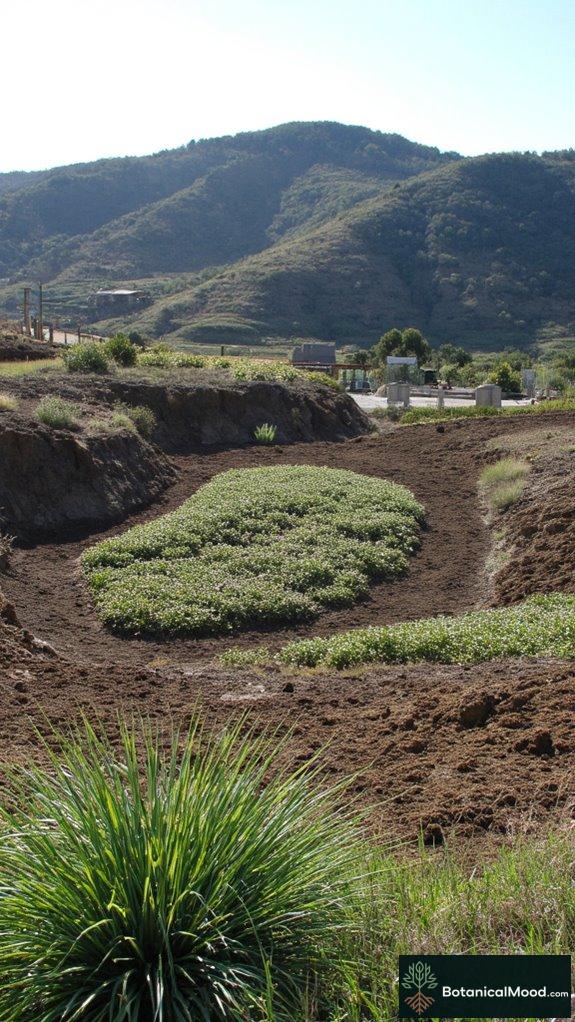
When I think about designing an organic garden, I can’t help but consider how embracing the natural contours of the terrain not only enhances aesthetic appeal but also promotes soil stability and health.
It’s essential to understand that the soil composition directly affects your garden’s liveliness; by working with the land’s slopes and dips, I’m able to optimize nutrient retention. This method naturally prevents erosion, allowing beneficial microorganisms to thrive.
For instance, I often incorporate native plants like *Echinacea purpurea*, which are excellent for preventing soil washout due to their robust root systems. Additionally, using sustainable terracing techniques can significantly improve water management and reduce runoff in sloped gardens.
Strategic Water Management With Swales

To optimize water retention and guarantee the health of my organic garden, I’ve found that incorporating swales into my surroundings is essential.
Swales are shallow, often curvilinear ditches that capture and direct rainwater, making them a natural irrigation solution.
By facilitating rainwater harvesting, swales help me maintain moisture levels in my soil, especially during dry spells, reducing the need for excessive watering.
As the water slowly percolates, it nourishes nearby roots of plants like *Salvia officinalis* and *Prunella vulgaris*, enabling robust growth.
Furthermore, swales create a charming, undulating terrain that enhances the garden’s beauty while ensuring safety from erosion and runoff.
This thoughtful design elevates my gardening experience, helping me connect more deeply with nature. Additionally, incorporating nectar sources for pollinators can enhance the biodiversity of my garden, attracting beneficial insects like butterflies and bees.
Selecting Plants for Alpine Success
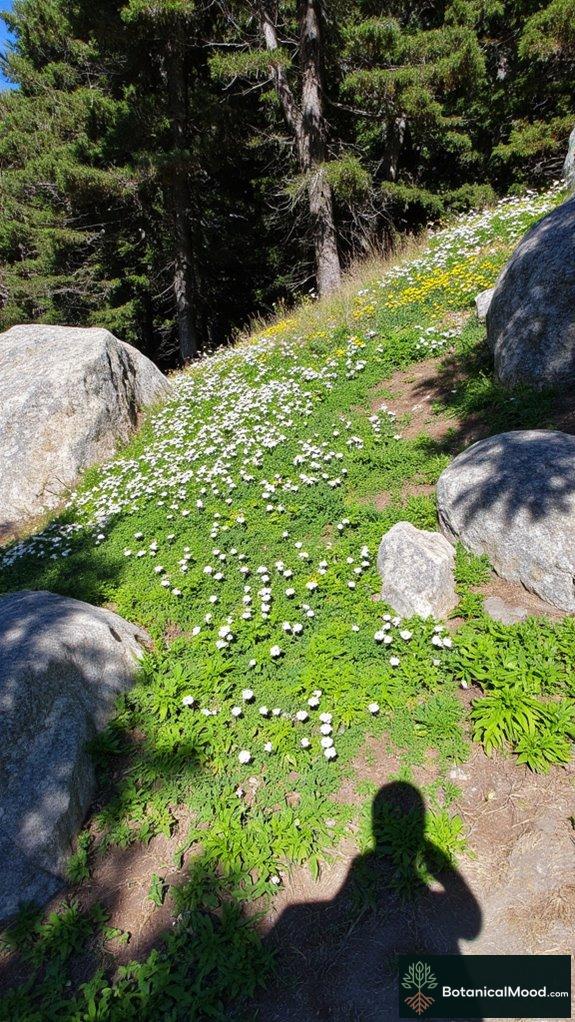
Choosing the right plants for an alpine garden can be challenging, yet it’s rewarding when you see the vibrancy they bring to your space.
To thrive in your unique alpine microclimates, focus on plant hardiness zones that suit your elevation and conditions.
Understanding your alpine microclimates is essential; choose plants that align with your elevation and environmental conditions for optimal growth.
Here are some favorites to contemplate:
- Edelweiss (Leontopodium alpinum): A symbol of rugged beauty, perfect for rocky spots.
- Mountain Avens (Dryas octopetala): Their white blooms bring a serene contrast to greenery.
- Alpine Buttercup (Ranunculus alpines): Bright yellow flowers that add a sunny touch.
- Saxifraga: A diverse genus, perfect for crevices and providing lush foliage.
- Blue Juniper (Juniperus squamata): This gentle groundcover stabilizes soil and offers color year-round.
These selections create a vibrant tapestry reflecting your alpine surroundings.
Enhancing Biodiversity With Native Species
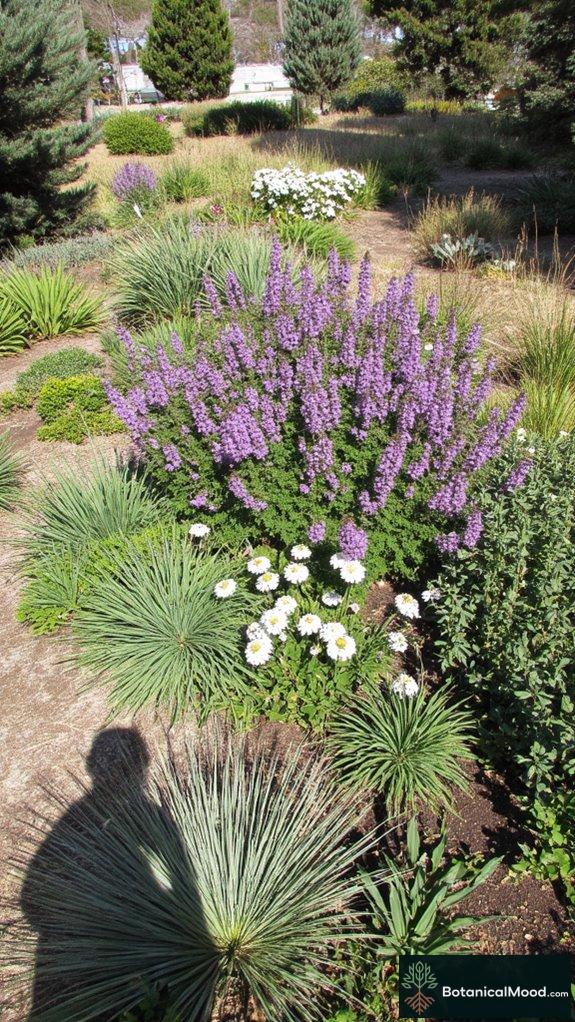
This focus on native flora brings forth the essential connections between our designed spaces and the surrounding natural world, promoting ecological stability while celebrating the unique charm of our geographic locations.
Incorporating native species like Echinacea purpurea and Asclepias tuberosa not only enhances visual appeal but also supports local ecosystems, inviting native pollinators such as bees and butterflies into our gardens.
By choosing plants that thrive naturally in our region, we cultivate a habitat that maintains ecological balance and minimizes the need for chemical fertilizers or pesticides.
I’ve found that this approach fosters a sense of safety and stewardship, allowing us to engage deeply with our environment.
Improving biodiversity enriches our lives while preserving the beauty of nature, forming a harmonious relationship that ultimately benefits us all.
Designing Hardscapes That Harmonize With Nature

While people often think of plants as the sole focus of garden design, the hardscape elements play an essential role in creating a cohesive outdoor environment that complements nature.
I’ve found that using natural materials not only enhances sustainable aesthetics but also guarantees safety in our spaces.
Consider incorporating these elements:
- Weathered stone pathways that blend with the surrounding scenery
- Locally sourced, untreated wood for seating areas
- Recycled concrete boulders that add texture and stability
- Natural gravel beds that provide effective drainage
- Soft, earthy tones in pavers that mirror the beauty of native flora
Each component invites harmony, leading to an organic flow that celebrates the outdoor sanctuary we aim to create, which inspired the vision behind Botanical Mood.
Effective Earthworks for Mountain Landscapes
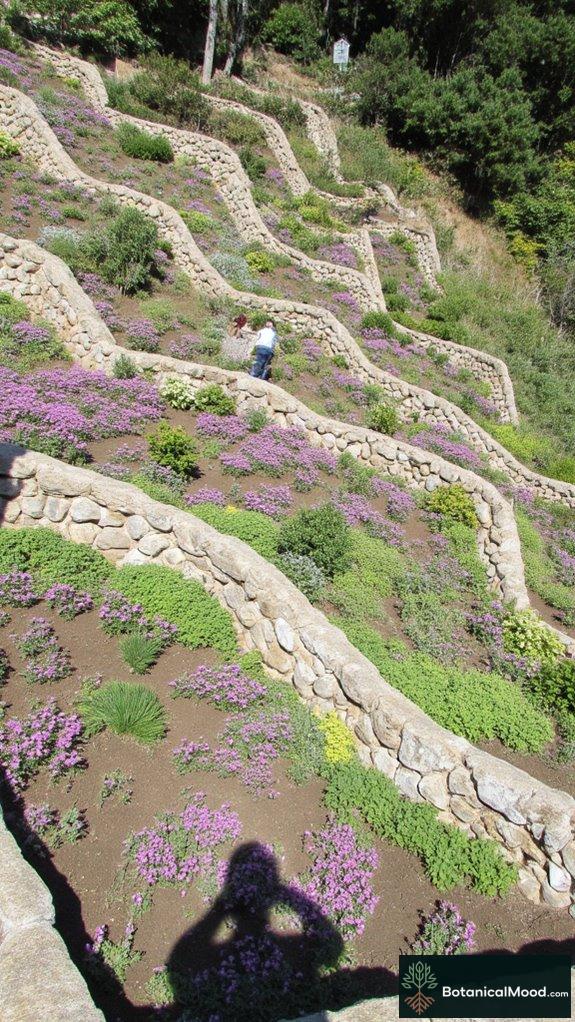
Building effective earthworks in mountain terrains isn’t just about moving soil; it’s a complex dance between nature and design, where each decision impacts the overall ecology and aesthetics of the area.
To combat soil erosion and guarantee slope stabilization, I utilize techniques such as terraces, retaining walls, and swales. These features promote water retention, reduce runoff, and enhance the scenery’s beauty. Here’s a table highlighting some essential earthwork strategies:
| Technique | Purpose | Best Plants |
|---|---|---|
| Terracing | Reduces erosion | Erigeron karvinskianus |
| Retaining Walls | Stabilizes steep slopes | Sedum spp. |
| Swales | Directs water flow, traps soil | Carex spp. |
| Contour Plowing | Prevents erosion on slopes | Asparagus officinalis |
Through these methods, I not only enhance safety but create a visually appealing, symbiotic relationship with the mountain scenery.
Creating Functional and Scenic Garden Pathways
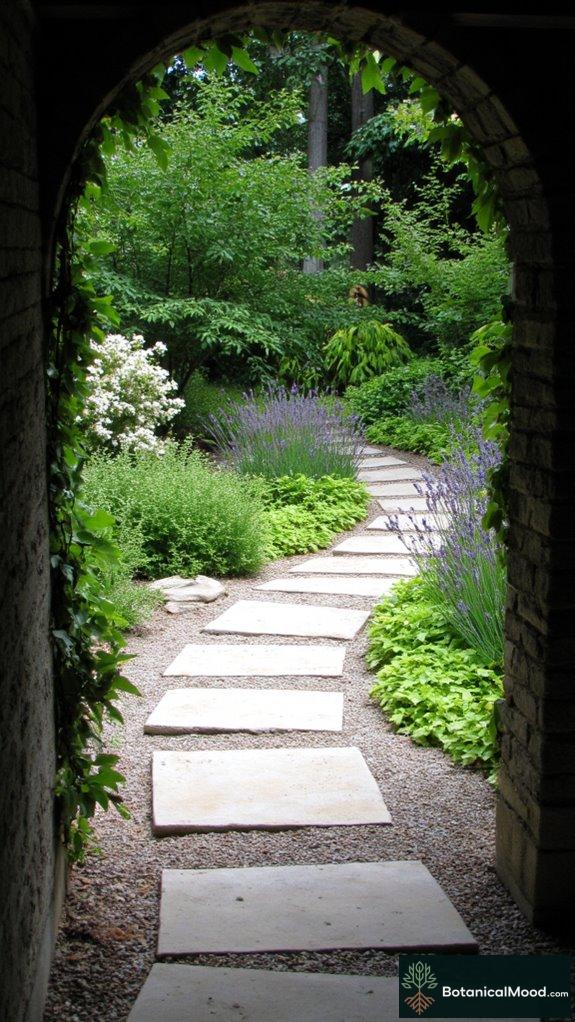
A thoughtfully designed garden pathway can transform an ordinary terrain into an enchanting journey, inviting exploration and enhancing the overall aesthetic of the space.
A well-crafted garden pathway invites exploration and elevates the beauty of your outdoor space.
When considering your pathway, envision elements that blend functionality with beauty:
- Smooth, durable flagstones from local quarries for safety and stability
- Soft, natural gravel for a rustic yet accessible touch
- Lush edging plants like Lavandula angustifolia(lavender) to create a sensory experience
- Subtle pathway lighting using energy-efficient LED fixtures, illuminating your path without harsh glare
- Inviting archways adorned with climbing Hedera helix(English ivy) that enhance the visual allure
Case Study: Mountain Design Impact
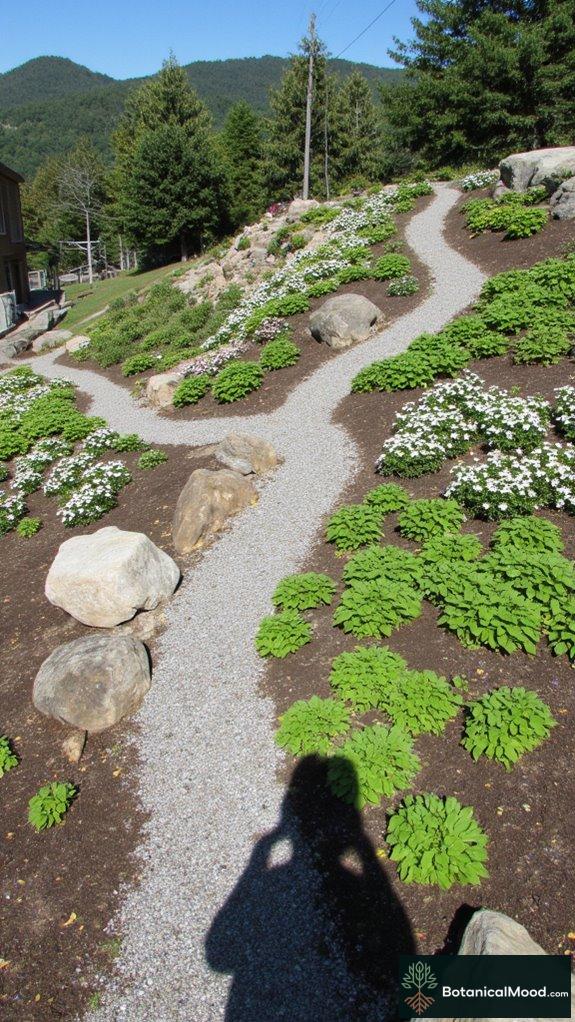
| Feature | Impact | Example |
|---|---|---|
| Native Flora Integration | Enhances ecology | *Trillium* spp., *Podophyllum* spp. |
| Water Management | Prevents erosion | Berms and terraces |
| Microclimate Creation | Improves growing conditions | Rocky placements |
| Functional Design | Guarantees access and safety | Gravel paths |
This study emphasizes the importance of thoughtful mountain design in creating resilient, beautiful gardens. The integration of native flora enhances the overall ecological health of the garden, creating a more vibrant and sustainable environment.
Terraced Planting for Elevation Appreciation

While terraced planting can evoke a sense of tranquility and elegance in any garden, it serves practical purposes that extend far beyond aesthetics.
- Sturdy stone retaining walls prevent erosion, securing each layer of your garden.
- Unique elevation gradients create distinct microclimates for diverse plant choices.
- Meandering paths enhance depth, making your terraced ecosystems feel expansive.
- Well-organized drainage systems maintain soil health and stability, preserving your investment.
- Layering plant heights introduces visual interest, allowing the interplay of light and shadow.
Owner’s Vision for Eco-Design
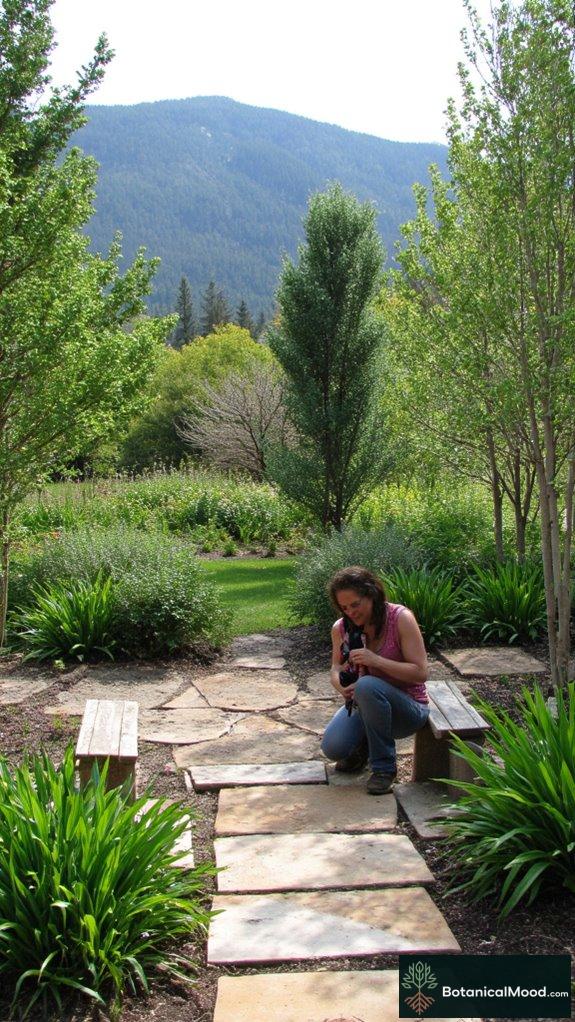
Claire Thompson from Colorado has always been inspired by the unique beauty of her mountainous surroundings, leading her to envision a sustainable garden that integrates seamlessly with nature and promotes local wildlife.
To achieve her eco-design vision, Claire enlisted the help of local horticulturists and garden designers. Through a collaborative design process, they identified the best native species, grouped in odd numbers for visual strength and ecological harmony, while adhering to xeriscaping principles to guarantee water conservation in her garden.
For the installation, Claire utilized tools from brands like DeWit for hand tools and Fiskars for ergonomic pruners.
She also incorporated accessories such as Weathered Stone natural pavers and rustic wooden benches from TumbleStone to enhance the garden’s aesthetic while maintaining an organic and natural feel.
Renowned Alpine Botanical Gardens
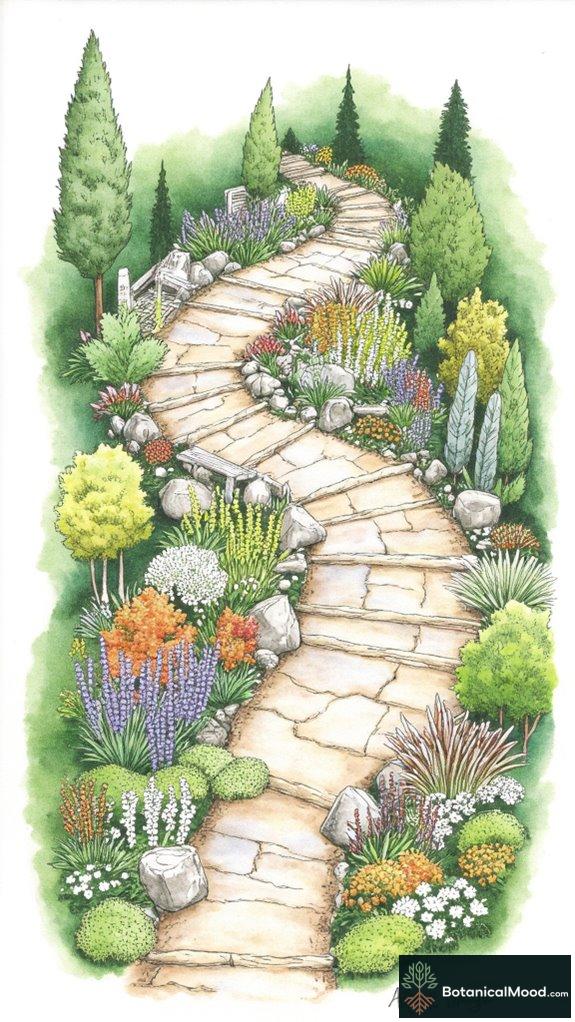
In the heart of the breathtaking Venetian Alps, renowned Alpine Botanical Gardens serve as living examples to the stunning diversity of flora in sub-alpine and alpine regions.
These four premier gardens showcase a rich collection of Alpine flora, highlighting species that thrive in limestone mountain habitats.
One enchanting spot is positioned on the eastern slopes of Mt. Hahnenkamm, where local volunteers cultivate organic integration of plants like Pulsatilla alpina.
These gardens not only emphasis botanical conservation but also promote awareness of climate adaptation, inviting visitors to experience educational trails that reveal seasonal variations and elevation-specific vegetation layers.
Such spaces exemplify community spirit and sustainability, harmonizing the botanical beauty of the Dolomites while preserving the exquisite ecosystem for future generations.
Garden Design FAQ
How Do I Test Soil Health for Mountain Gardening?
I test my soil health by conducting soil testing for a nutrient analysis. It tells me about pH levels and nutrient content, ensuring I create a safe, thriving environment for my mountain garden plants.
What Tools Are Best for Measuring Slopes Accurately?
I prefer using a clinometer for accurate slope measurement and a leveling tool for terrain assessment. These tools help me guarantee safety while working on slopes, making my gardening experience both enjoyable and secure.
Can Contour Gardening Be Scaled for Urban Environments?
I’ve found urban contouring benefits my small garden by maximizing space. With space optimization techniques like raised beds and terracing, I can safely cultivate a diverse garden, even in limited urban areas.
How Do I Incorporate Wildlife Habitats Into My Design?
I incorporate wildlife habitats by choosing wildlife-friendly plants and integrating native species. I focus on creating safe spaces with diverse flora, offering essential food and shelter while ensuring a secure environment for all creatures visiting my garden.
What Maintenance Is Required for Swales Over Time?
Maintaining swales is like tending a delicate balance; it requires regular checks for erosion control and periodic plant trimming. I make sure to repair any damage and keep the vegetation healthy for safety and effectiveness.
References
- https://www.tenthacrefarm.com/contour-gardening-minimize-irrigation/
- https://www.gardendesign.com/colorado/mountain-tips.html
- https://permacultureapprentice.com/food-forest-with-swales-layout-pfdc/
- https://majesticmeadows.blog/2022/01/26/mountain-garden-ideas/
- https://treeyopermacultureedu.com/chapter-9-earth-working-and-earth-resources/earthworks-best-practices-design-context-building/
- https://www.permaculturegardens.org/design-your-permaculture-garden
- https://www.youtube.com/watch?v=M7gogJ4KQW0
- https://www.gardensrevived.com/latest-news/contours-in-garden-design
- https://siffordgardendesign.com/projects/5305225-crafting-a-mountain-garden-called-rhodwood
- https://www.finegardening.com/article/build-your-own-rocky-mountain-rock-garden
- https://www.finegardening.com/article/jays-garden-in-the-mountains
- https://www.porvenirdesign.com/blog/2021/9/19/the-tropical-permaculture-homestead
- https://bigrockinc.com/mountain-style-landscaping-how-to-create-a-natural-look-for-your-home/
- https://naturesperspective.com/case-study-tasteful-throwback/
- https://ewspconsultancy.com/2024/07/17/colorado-permaculture-design-mountain-garden-design/
- https://awaytogarden.com/crevice-gardens-brave-new-rock-gardens-with-kenton-seth-and-paul-spriggs/
- https://www.organic-lock.com/category/case-study/
- https://gadsdengardens.co.uk/landscaping/elevation-garden-transformation/
- https://www.quercusgardens.com.au/2023/12/04/terraced-garden-design-elevation-and-elegance/
- https://masterslandscapedesign.com/landscaping/elevation-landscaping-elevating-views-and-property-value/

Leave a Reply